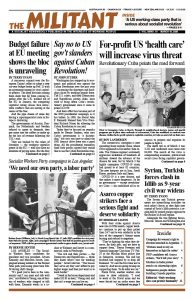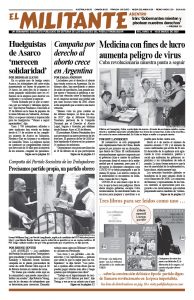Washington has stepped up its economic and political war against the Cuban Revolution over the past year — increasing the shortages and hardships faced by working people there. The U.S. rulers, and their Democratic and Republican parties alike, have tried to bring down Cuba’s revolutionary government since it came to power in 1959.
And their effort has become part of the 2020 presidential campaign, as it has before. In 1960, the liberal John F. Kennedy blamed then Vice President Richard Nixon for allowing the Cuban Revolution to succeed.
Today they’ve focused on remarks made by Bernie Sanders, who says Cuba’s government is “a dictatorship,” but says you have to admit the 1961 literacy drive there was a good thing. All the presidential wannabes from both parties agreed they would like to see the Cuban Revolution overthrown, but Sanders was roundly criticized for saying the literacy drive had been positive.
Washington has increased sanctions on companies shipping oil to Cuba, tightened travel restrictions to the island and limited remittances that Cuban Americans can send back to their families. Last April it activated a section of the Helms-Burton Act to encourage U.S. citizens to sue individuals and companies that do business with Cuba using property that was nationalized after the revolution. In October the U.S. rulers banned Cuba from purchasing goods that contain more than 10% U.S.-made components.
“The U.S. blockade against Cuba constitutes the most unjust, severe and prolonged system of unilateral coercive measures ever applied against any country,” said Cuban Foreign Minister Bruno Rodríguez on Feb. 3, the 58th anniversary of Kennedy’s imposition of the punishing embargo.
The U.S. capitalist class has never forgiven Cuba’s workers and farmers for making a revolution. Under the leadership of Fidel Castro, they overthrew the Fulgencio Batista dictatorship, established a workers and farmers government and put an end to capitalist ownership of the country’s factories, land and banks. And they transformed themselves in the process and took command of running society.
Castro described the program of the revolution in a Sept. 2, 1960, speech to over a million Cubans that is known as the First Declaration of Havana.
He said the Cuban people proclaim: “The right of peasants to the land; the right of workers to the fruit of their labor; the right of children to education; the right of the sick to medical and hospital care; the right of the young to a job; the right of students to free education that is both practical and scientific; the right of Blacks and Indians to ‘full human dignity’; the right of women to civil, social, and political equality; the right of the elderly to a secure old age; the right of intellectuals, artists, and scientists to use their work to fight for a better world; the right of states to nationalize the imperialist monopolies,” and more.
And Cuban working people went forward and acted on this program — one that would be attractive to working people in the U.S. and around the world.
Cuba’s literacy drive
The Wall Street Journal responded to Sanders’ comments on the 1961 literacy drive by claiming that campaign wasn’t a big deal. They said almost 80% of the population were literate before the revolution.
But the literacy drive wasn’t aimed at the capitalists or middle-class in Cuba who could read, many of whom had packed their bags and fled to the United States. It was aimed at drawing the workers and peasants — whose literacy rate was qualitatively lower — more deeply into taking command of their revolution.
Some 250,000 young volunteers mobilized to teach 700,000 fellow toilers, mostly workers, Afro-Cubans and peasants, to read and write. As they led the fight to wipe out illiteracy, the volunteers and their students alike gained growing confidence in their own capacities and the deepening revolution.
“Illiteracy is a tool in the hands of the exploiters. If you are ignorant, if you don’t know how to read or write, you’re not free,” explained Asela de los Santos, a leader of the revolution, in the book Women in Cuba: The Making of a Revolution Within the Revolution. De los Santos was in charge of organizing schools during the revolutionary war in 1958, which helped lay the foundations for the literacy campaign.
The liberal NPR brought Cuba “scholar” Andy Gomez on a Feb. 26 talk show to “explain” why Castro wanted people to be literate. “To indoctrinate the children to a Marxist ideology,” the “scholar” opined.
The U.S. rulers use these slanders to try and persuade those attracted to the liberating example of the Cuban Revolution that far from presenting a road to end the many forms of oppression engendered under capitalism, it offers only the suppression of individual freedom. Sanders’ labeling the Cuban government “a dictatorship” fits into their efforts.
The Cuban Revolution was a popular uprising that led workers and farmers to expropriate millions of acres of the largest landed estates. Some 100,000 peasants won title to land of their own. The government nationalized the big factories, plantations and utilities, whose bosses either fled or resisted the revolution, and reorganized them under workers control.
In contrast to the big-business press and all the Republican and Democratic presidential hopefuls, the Socialist Workers Party presidential ticket — Alyson Kennedy for president and Malcolm Jarrett for vice president — point to the class interests working people in the U.S. have in defending the Cuban Revolution. And they explain what workers can do today to organize to fight the attacks of the bosses and their government. As we do so we advance our self-confidence, fighting capacities and win allies in struggle among all the oppressed and exploited.
This is the road towards building a movement of millions that can emulate the Cuban Revolution and take power out of the hands of the capitalists — the class enemy of working people both here and in Cuba.

